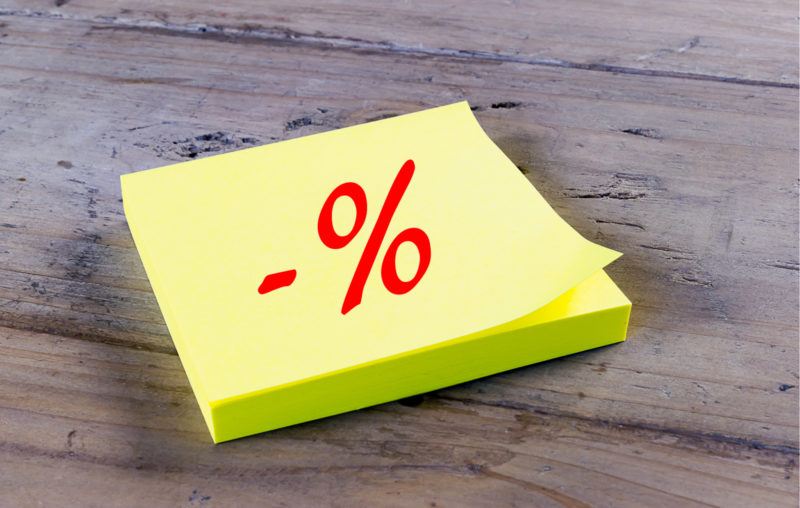Negative Interest Rates: A Free Market Phenomenon

Last week, Federal Reserve Chair Jerome Powell poured cold water on negative interest rates. They are “not something we’re looking at,” he said.
Just a few hours before, and on the opposite side of the world, New Zealand’s central bank was warming up to them. Negative interest rates “will become an option in future” and discussions with New Zealand banks about “preparing for a negative OCR” are ongoing.
Which of these two contrasting views on negative interest rates is right?
I’m going to side with the Reserve Bank of New Zealand on this. I’ve been saying for a few years now that central banks like the Federal Reserve should have carte blanche to set negative interest rates.
Many people have a visceral response to negative interest rates. “They’re unnatural!” people angrily tell me. Economic logic demands that debtors incur interest and lenders deserve a reward for parting with their savings. Any inversion of this time-honoured rule can only be an abomination foisted on citizens by governments.
But negative interest rates are not unnatural. They are a regular phenomenon in unregulated free markets.
No economic nook is less regulated than the cryptocurrency space. In a provocative article, pseudonymous cryptocurrency researcher Hasu shows how negative interest rates are frequently used in cryptocurrency markets.
Perpetual swap contracts are the best example. Most people who want exposure to the price of bitcoin buy actual bitcoins on a spot exchange. But a number of crypto exchanges such as BitMEX, OKex, and Deribit offer derivatives, or financial insturments such as futures and options, that provide more concentrated bitcoin price exposure.
The most popular of these derivative contracts is known as a bitcoin perpetual swap contract. Bear with me as I explain how these contracts work. Later I’ll swing back to negative interest rates and central banking.
The price of these perpetual swap contracts is designed to move in-line with the price of underlying bitcoins. People who want to profit from a price rise go long and buy the contract. Those who expect bitcoin to fall, the shorts, take the other side of the bet and sell contracts.
Most types of derivative contracts stay locked to the price of the underlying commodity they represent via settlement. At some point in the future, one party to the derivative contract has to transfer the actual commodity to the other party.
But not perpetual swap contracts. They don’t settle. Sellers never have to deliver actual bitcoins to buyers.
How then does the price of the perpetual contract stay pegged to the price of actual bitcoin? Exchanges like BitMEX have come up with an ingenious trick for nudging the contract price back in-line with the bitcoin price. They use an interest rate called the funding rate.
The funding rate is a fee that longs must pay to the shorts. Typically, there is more demand to go long bitcoin perpetual contracts than to go short. And so the longs have a tendency to push the price of the contract above the price of bitcoin. By increasing the funding rate, BitMEX obligates longs to pay the shorts more money. This payment flow encourages more people to take the short side of the market (and fewer to take the long side). And so the price of the perpetual contract gets refixed to the price of bitcoin.
Here’s an example. Let’s say that BitMEX’s perpetual contract is trading in-line with bitcoin. Both are at $10,000. The funding rate is 0%. The longs are not paying an interest to the shorts.
Suddenly, more long players want to buy perpetual contracts. The price of the perpetual contract rises to $10,500 or so, $500 above bitcoin’s price. In reaction, BitMEX automatically increases the funding rate from 0% to, say, 50%. Long players must now pay a 50%/year fee to the shorts.
This carrot entices more short players into the market. They compete to sell contracts. The price of the perpetual contract is pushed back down until—voila—it is once again pegged to the price of bitcoin.
BitMEX’s funding rate tends to be positive. But sometimes it goes negative.
This occurs when there are too many shorts, or sellers, in the market, and the price of the perpetual contract falls below the price of bitcoin. To help rebalance the system, the funding rate gets ratcheted down into negative territory. That is, short players (who typically receive interest) must now pay interest to the longs. This negative fee incentivizes more speculators to buy the contract, pushing its price back up to par with bitcoin.
As Hasu points out, negative funding is “the most normal thing in the world” to people who are active in the bitcoin market. It’s the system’s natural way to regain its peg.
Hasu suggests we can apply this same logic to central banks like the Fed. Just like there are some who want to go long on bitcoin while others want to short it, there are some who want to go long on the dollar while others want to short the dollar.
Who are the people who go long, or buy, dollars? These are people who hold banknotes in their wallets or keep dollar balances in accounts at the Fed. Those who are short, or have sold dollars, have effectively borrowed dollars from the Fed. They’ve sold these borrowed dollars in the market, perhaps to cover debts or buy other securities. For example, anyone who has a mortgage is short on dollars, having borrowed money and sold it to buy a house.
In dollar land, interest rates tend to be positive. That is, the dollar shorts typically pay a fee to longs. This means that the longs, who have an account at the Fed, receive interest. The shorts, those who borrow from the Fed, pay it.
Recall that BitMEX targets the price of its perpetual contract to the price of bitcoin. Central banks have typically chosen a different target, a basket of consumer goods. Both BitMEX and the Fed rely on changes to interest rates to balance out supply and demand for contracts (or dollars) in a way that ensures that it hits its target, whether that be bitcoin or a basket of consumer goods.
In times of stress, the demand to go long dollars spikes. Dollars, after all, are safe and stable. The dollar shorts desperately repurchase dollars to cover their debts. And so the dollar’s price rises far above the Fed’s target. To help restore its target, the Fed needs to encourage short sellers and discourage longs. That means reducing the fee that shorts are typically obliged to pay the longs. Or, put differently, interest rates have to be cut.
How low should the Fed reduce interest rates?
Sometimes BitMEX has to go negative to keep contracts moored to the bitcoin price. If free crypto markets have accepted negative rates as a legitimate way to hit a target, why shouldn’t central banks like the Fed do the same if they are serious about hitting their targets?










